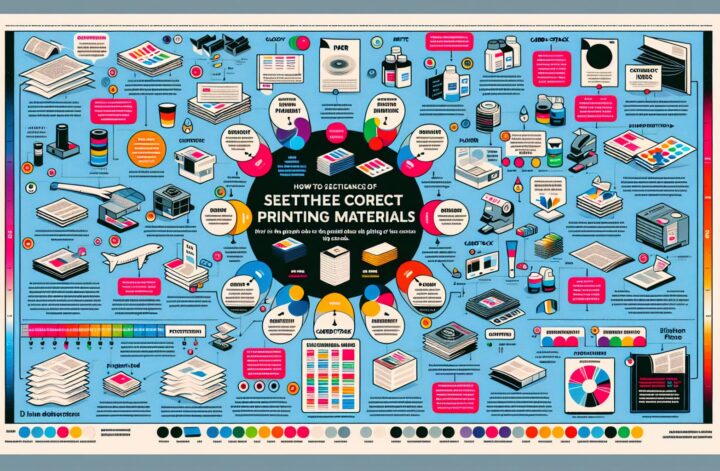Introduction
Printing materials are an essential aspect of any successful printing project. Whether you’re looking to print documents, marketing materials, or even 3D objects, the right materials can make all the difference in achieving the best results. In this ultimate guide, we will explore various printing materials, their properties, and their suitability for different printing applications. So, let’s delve into the world of printing materials and discover how they can elevate your printing projects to new heights.
Body
1. Paper
Paper is the most commonly used printing material, widely employed for printing documents, brochures, flyers, and more. It comes in different weights, sizes, and finishes, making it versatile for various purposes. Here are some popular types of paper:
-
Bond paper: Also known as writing paper, bond paper is commonly used for everyday printing needs such as letters, contracts, and memos. It provides a smooth and clean surface that is easily writable.
-
Coated paper: Coated paper has a glossy or matte finish and is ideal for high-quality printing, such as magazines and catalogs. The coating enhances color vibrancy and image sharpness, making it a preferred choice for vivid graphic designs.
-
Recycled paper: As sustainability becomes increasingly important, recycled paper offers an eco-friendly alternative. It is made from post-consumer waste and has similar characteristics to regular paper, making it suitable for various printing projects.
2. Cardstock
Cardstock is a thicker and sturdier type of paper, often used for crafting, invitations, business cards, and postcards. It provides a more professional and durable feel compared to regular paper. Here are some common cardstock options:
-
Matte cardstock: Matte cardstock has a non-glossy, smooth finish, which is ideal for designs that require a sophisticated look. Its characteristics make it perfect for wedding invitations, menus, and high-end greeting cards.
-
Glossy cardstock: If you’re looking for vibrant colors and a shiny finish, glossy cardstock is the way to go. It adds a professional touch to marketing materials like brochures, flyers, and promotional cards.
-
Textured cardstock: Textured cardstock comes in various textures, such as linen, canvas, or laid. It adds depth and interest to any project, making it suitable for arts and crafts, scrapbooking, and special occasion invitations.
3. Vinyl
Vinyl is a versatile material widely used for large format printing, signage, and decals. It offers durability and weather-resistance, making it suitable for both indoor and outdoor applications. Here are some common vinyl options:
-
Adhesive vinyl: Adhesive vinyl is widely used for signage, window graphics, and decals. Its adhesive backing allows it to stick to various surfaces, making it highly versatile. It is available in different finishes, such as glossy, matte, or transparent.
-
Heat-transfer vinyl: Heat-transfer vinyl is specifically designed for fabric printing. It can be cut into shapes or designs and applied to t-shirts, bags, and other fabric items using heat and pressure. It comes in a wide range of colors and finishes.
-
Static cling vinyl: Static cling vinyl does not require adhesive and can stick to smooth surfaces such as glass or mirrors using static electricity. It is commonly used for window clings, decorative displays, and temporary signage.
4. 3D Printing Materials
3D printing has revolutionized the manufacturing industry, allowing the creation of complex shapes using various materials. Here are some commonly used materials in 3D printing:
-
PLA (Polylactic Acid): PLA is the most common and beginner-friendly 3D printing material. It is biodegradable, derived from renewable resources such as corn starch or sugarcane, and offers a wide range of colors. It is suitable for prototypes, decorative objects, and functional prints with low-stress requirements.
-
ABS (Acrylonitrile Butadiene Styrene): ABS is popular for its strength and durability. It is commonly used in functional parts, such as mechanical components, toys, and car parts. ABS requires a heated print bed and fume extraction due to the fumes it emits during printing.
-
PETG (Polyethylene Terephthalate Glycol): PETG offers a balance between ease of printing and strength. It is less prone to warping, making it suitable for larger prints and functional prototypes. PETG is also food-safe, making it appropriate for containers and items that come into contact with food.
-
Nylon: Nylon is a strong and flexible material, ideal for printing durable parts, gears, and mechanical components. It requires specific printing conditions, such as a heated chamber and specialized settings, due to its high printing temperatures.
-
Metal filaments: Metal filaments combine metal powder with a binder material, allowing 3D printers to produce metal-like prints. These prints can then be refined through polishing, sanding, or other post-processing techniques to achieve a metallic appearance.
Conclusion
When it comes to printing materials, it’s important to choose the right material for your specific project. Paper is the go-to choice for everyday documents, while cardstock adds a professional touch to various printed materials. Vinyl offers durability and versatility for signage and large format applications. Finally, 3D printing materials present a world of possibilities for creating complex and functional objects.
By understanding the properties and suitability of different printing materials, you can ensure your projects not only look great but also meet their intended purposes. So, next time you embark on a printing journey, choose your printing material wisely, and watch your designs come to life in the most remarkable way possible!


